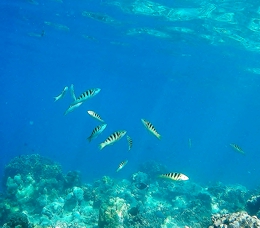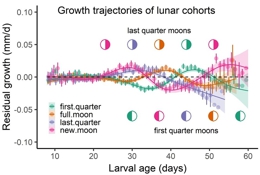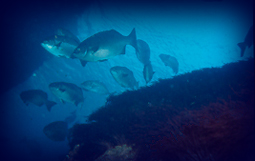|
Reproductive phenology and lunar rhythms
Moonlight drives a dynamic landscape of risk and reward for a wide range of organisms. The moon plays a particularly strong role in the ocean, where it synchronises reproduction, mediates the tidal delivery of resources and propagules, and suppresses nightly mass migrations of the most numerous vertebrate predators on Earth (e.g., lanternfish, that hunt reef fish larvae at night). Lunar-mediated processes likely determine productivity, resilience and community structure of many reef ecosystems. Nonetheless, ecological and evolutionary consequences of moonlight remain essentially unknown. How does moonlight shape the evolution of early life-history strategies in the sea?
Our recent work on the sixbar wrasse (a representative coral reef fish that has served as a useful model for our work for over 20 years) suggests that reproductive patterns and population replenishment follow a lunar schedule (Shima et al. 2018, 2020, Mitterwallner and Shima 2022a,b). Sixbars are highly iteroparous, and spawning activity is observable on most days throughout the year. However, many more eggs are spawned during the new moon, and this is perplexing because offspring born at the new moon are far less likely to survive their larval stage. Selection should favour adults spawning more around the full moon—and this just doesn’t happen.
Why do adults spawn at seemingly bad times? Part of the answer may come from an eco-evolutionary feedback—essentially, the interplay between decisions made by parents, and subsequent (compensatory) decisions made by their offspring (Shima et al. 2018). But another explanation may come from lunar rhythms in growth. By using otoliths (i.e., fish “earbones”) to reconstruct growth histories, we discovered that larval sixbars grow best during the last quarter moon and worst during the first quarter moon (Shima et al. 2021).
Larval growth rates in another of our favourite study species (the common triplefin) also appear to be linked to phases of the moon (Shima and Swearer 2019).
We hypothesise that the moon drives a dynamic landscape of risk and reward for larval stages of marine reef organisms. These dynamics are driven by the moon’s effects on the nightly vertical migrations of mesopelagic predators (e.g., lanternfish) and supplemental prey (e.g. copepods), which are altered by nighttime illumination.

A dynamic landscape of risk and reward across the lunar month, driven by the shifting pattern of moonrise/moonset, and its effects on vertically migrating prey and predators. Moonlight supresses the upward migration of both predators and prey; predators migrate from deeper depths and therefore don't approach the surface until later in the night. Larval fish develop near the sea surface (yellow symbols) and are likely to benefit from supplemental prey (brown) and an absence of predators (red) near the surface at nights close to the last quarter moon, and vice versa during the first quarter moon. |
|
.gif) |
Lunar phases drive tides, currents, and nocturnal illumination. Reproduction and migrations of marine animals are shaped by all of these.
|
 |
Sixbar wrasse spawn more eggs at the new moon
|
| |
 |
Larval fish growth varies on a lunar cycle. The best times for growth correspond to last quarter moons, the worst times for growth correspond to first quarter moons. Spawning date determines the age at which larvae experience good and bad growth. Spawning on the new moon gives offspring two bouts of good growth, with the second coinciding with settlement.
|
 |
Our ongoing work aims to test this hypothesis, and its implications. How does an altered pattern of nocturnal illumination (e.g., light pollution from coastal cities, coastal darkening due to increased suspended sediments in the water column) affect this dynamic landscape of risk and rewards at sea? How might climate-driven changes in nocturnal cloud cover alter fisheries productivity?
Key Collaborators
Steve Swearer – University of Melbourne
Craig Osenberg – University of Georgia
Suzanne Alonzo – University of California, Santa Cruz
Erik Noonburg – Independent Researcher
For more information, see:
Research publications
Shima, J. S., & Swearer, S. E. (2019) Moonlight enhances growth in larval fish. Ecology, 100:e02563.
Shima, J. S., Osenberg, C. W., Alonzo, S. H., Noonburg, E. G., Mitterwallner, P., & Swearer S. E. (2020). Reproductive phenology across the lunar cycle: parental decisions, offspring responses, and consequences for reef fish. Ecology, 101, e03086.
Shima, J. S., Osenberg, C. W., Noonburg, E. G., Alonzo, S. H., & Swearer, S. E. (2021) Lunar rhythms in growth of larval fish. Proc. Royal. Soc. B. 288: 20202609.
Hillyer, K. E., Beale, D. J., & Shima, J. S. (2021) Artificial light at night interacts with predatory threat to alter reef fish metabolite profiles. Sci. Total Environ. 769: 144482.
Shima, J.S., C.W. Osenberg, S.H. Alonzo, E.G. Noonburg, and S.E. Swearer. (2022) How moonlight shapes environments, life histories, and ecological interactions on coral reefs. Emerging Topics in Life Sciences DOI 10.1042/ETLS20210237
Mitterwallner, P. and J.S. Shima. (2022) The relative influence of environmental cues on reproductive allocation of a highly iteroparous coral reef fish. Coral Reefs DOI: 10.1007/s00338-022-02239-6
Mitterwallner, P. and J.S. Shima. (2022) Influence of the lunar cycle and spatial gradients on sizedependent male and female reproductive investment decisions of a protogynous reef fish. Marine Biology 169:129
Shima J.S., S.H. Alonzo, C.W. Osenberg, E.G. Noonburg, and S.E. Swearer. (2024) Lunar rhythms and their carry-over effects may shape environmental sex determination in a coral reef fish. Proceedings of the Royal Society B-Biological Sciences 291: 20240613
Noonburg E. G., S.H. Alonzo, C.W. Osenberg, S.E. Swearer, and J.S. Shima. (2024) Patterns of spawning and settlement of reef fishes as strategic responses to post-settlement competition. Theoretical Population Biology 160: 1–13
Media coverage / popular articles
Shima, J. S., Osenberg, C. W., Swearer, S. E., & Alonzo, S. H. (2021) Under the moonlight: a little light and shade helps larval fish to grow at night. The Conversation. link to article
Data sets
Shima, J. S., Osenberg, C. W., Noonburg, E. G., Alonzo, S. H., Swearer, S. E. (2021) Data from: Lunar rhythms in growth of larval fish. Dryad Digital Repository. link to data
|
|
|

.gif)







